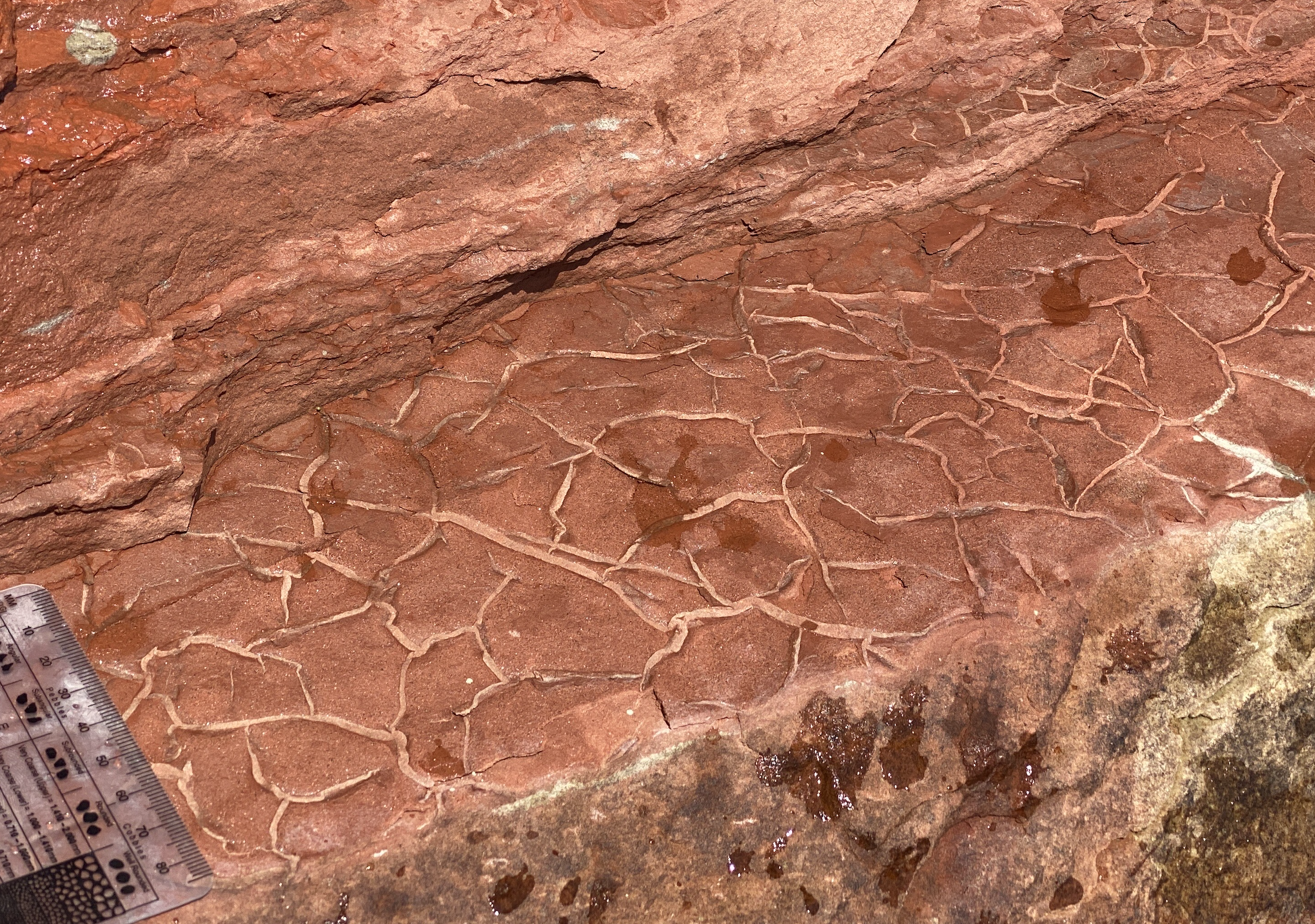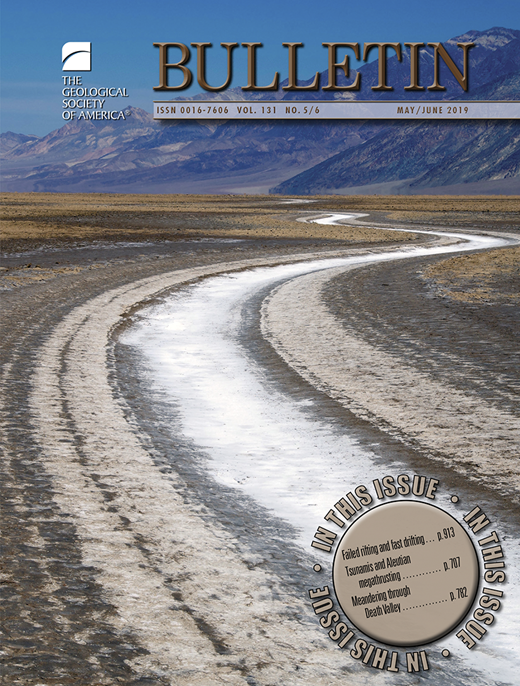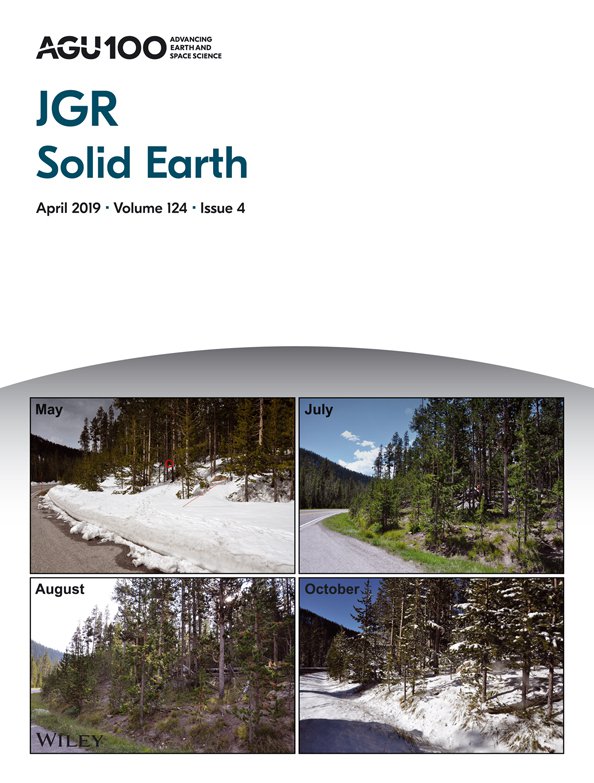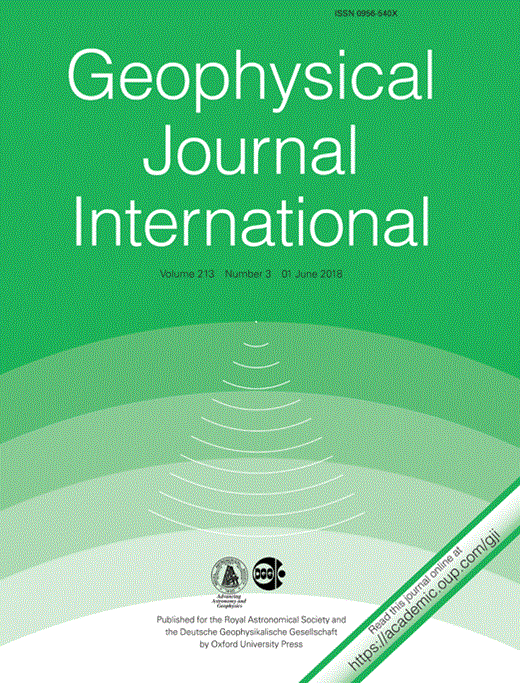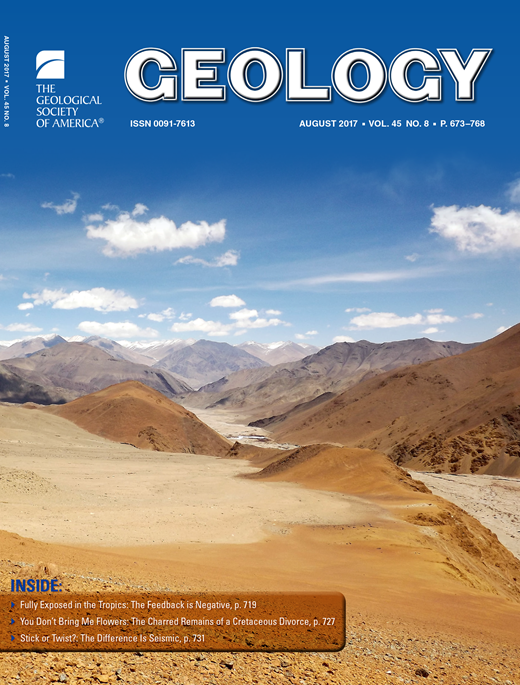
1.1 Billion years ago a large volcanic rift system developed in the middle of the North American continent. Through the study of the lava flows and sediments that accumulated during rifting we can learn about the rapid continental motion and the behavior of the ancient geomagnetic field as the supercontinent Rodinia was assembling .
The geocentric axial-dipole hypothesis for Earth’s magnetic field and the problem of Keweenawan “reversal asymmetry”
Measurements of paleomagnetic remanence are used to develop paleolatitude constraints using the working hypothesis that the surface expression of Earth’s geomagnetic field averages out to a geocentric axial dipole (GAD) where the inclination of magnetization (I) is a simple function of latitude (λ) that can be determined using the “dipole equation”:
$\tan(\mathrm{I})=2\tan(\lambda) $

Illustration of a dipole field and the relationship between latitude and inclination. A 100% dipole field is shown aligned with Earth’s rotational axis. Cartoon inclinometers are shown at different latitudes where they have aligned themselves with the dipole field. The equal area plot depicts the angle of the inclination for each inclinometer relative to Earth’s surface. The field is horizontal at the equator (#1) and vertical at the north pole (#4). These relationships between inclination (I) and latitude (λ), and those of #2 and #3, can be represented with the dipole equation.
Under the GAD hypothesis, paleomagnetic data that span enough time to average out the short time-scale secular changes to the Earth’s magnetic field (geomagnetic secular variation) should produce a paleomagnetic pole that corresponds to Earth’s geographic spin axis when calculated with the dipole assumption. This hypothesis has been demonstrated to be robust for the past 10,000 years on the basis of the magnetization of archeological sites and recent sediments (McElhinny et al., 1996). For the past 5 million years, compilations of paleomagnetic data are best with a GAD field that has quite minor persistent contributions from non-dipole components (1-5 %; Johnson and Constable (1997); Tauxe and Kodama (2009); Valet et al. (2011)). For the past 150 million years, plate reconstructions can be made independent from paleomagnetic data, and in following through with such reconstructions, and analyzing the results, positions of paleomagnetic poles reveal a primary GAD field with only a small (3% − 5%) axial quadrupole component (Besse and Courtillot, 2002). These results suggest that taking the ancient field to be dominantly a GAD is a great working hypothesis for turning measured directions of paleomagnetic remanence into constraints on paleogeography. However, given that there are non-dipole contributions to the geomagnetic field at present, and evidence for their persistence as small contributions over the past 100+ million years, there exists the possibility that there were periods of Earth history when non-GAD contributions to the field were significant. Both the end of the Mesoproterozoic Era and the end of the Neoproterozoic Era have been implicated as time periods when there were large non-GAD contributions to the geomagnetic field that significantly changed the field’s geometry (Abrajevitch and Van der Voo, 2010; Pesonen and Nevanlinna, 1981).
It was analysis of paleomagnetic data sets from the 1.1 billion-year-old Keweenawan Midcontinent Rift of North America that led to the interpretation that a period of large non-GAD contributions to the geomagnetic field occurred as Rodinia was assembling and the Mesoproterozoic was drawing to a close. This challenge to the GAD hypothesis stemmed from the observation that paleomagnetic directions from the Midcontinent Rift consistently reveal normal and reversed directions that are not antiparallel (with inclination differences of 20°-30°; Halls and Pesonen (1982)). Since reversals of a dipolar field would be antiparallel (symmetric) this “problem of Keweenawan reversal asymmetry” has been explained as due to the introduction of large non-GAD contributions to the field (Nevanlinna and Pesonen, 1983; Pesonen and Nevanlinna, 1981).
The figure below provides an example of how the introduction of significant non-axial dipole components skews the interpretation of paleolatitude data if interpreted using the dipole equation. The resulting mismatch between true and interpreted paleolatitude introduces large inaccuracies in paleogeographic reconstructions if not identified, and large uncertainties if such contributions are not fully understood. Furthermore, this mismatch could alter interpretations of the paleolatitude of climatically relevant sedimentary units such as glacigenic rocks whose paleolatitude, determined using the dipole equation, is currently used to make significant inferences about climate (e.g. Neoproterozoic “Snowball Earth” events). Therefore, the interpretation of large non-GAD contributions at the end of the Mesoproterozoic Era is discussed in many treatments of the paleogeography of the time period as a source of significant uncertainty. It is unsatisfying for large uncertainty to persist if we are to apply paleomagnetic data to the underlying questions about Rodinia’s assembly, positioning and break-up. This reality demanded that a fresh look be taken to test “reversal asymmetry” and, if such asymmetry was verified, to provide new constraints such that the non-GAD contribution could be further quantified and applied to paleogeographic reconstructions.

Illustration of the effect on inclination of a large and persistent quadrupole contribution to the geomagnetic field. In the calculation depicted, a non-reversing geocentric axial quadrupole (G20) comprises 20% of the contribution to the field while a geocentric axial dipole (G10) reverses from being reversed (red) to normal (blue). Next to the illustration of this field are plots of calculated versus true paleolatitude if the calculation is made using the dipole equation. The green line is for a purely dipolar field (wherein “apparent” paleolatitude is the same as real paleolatitude), while the purple line is for the field shown. For the latitude depicted by the orange star (50°), the apparent paleolatitude is skewed to higher latitudes for the reversed dipole (upper right) and to lower latitudes for the normal dipole (lower left). The combined effect is for there to be a ∼25° difference in inclination across the reversal causing “reversal asymmetry.”
The Midcontinent Rift of North America and its rich record of paleogeographic change The Midcontinent Rift is a large igneous province that outcrops extensively in the Lake Superior region and continues far to the southwest—forming a >2500 km arcuate swath that is prominent in gravity and aeromagnetic data of North America. Rifting initiated at ∼1109 million years ago and associated volcanism continued, albeit with hiatuses in different regions, to 1086 Ma (Davis and Green, 1997) when volcanism ceased. The end of volcanic activity and active normal faulting occurred before the rift was able to dismember the Laurentian craton. As a result, the rift is labeled as “failed” and geoscientists are left with a thick intact record of rift volcanism and sedimentation. Had the rift succeeded, North America would not exist as we know it and there is a high likelihood that modification by subsequent passive margin sedimentation and eventual orogenesis would have resulted in a far less pristine record. It has been estimated that more than 2 million km^3 of volcanics erupted throughout the history of rift volcanism (Cannon, 1992). The protracted history of volcanism, as well as the prodigious volume, make the volcanics, intrusives and rift-related sediments of the Keweenawan Rift very important archives of paleogeographic information as Rodinia assembled. Paleomagnetic data from the rift have led to a series of paleomagnetic poles that form an apparent polar wander path known as the “Logan Loop” for the older high-latitude poles which then continue into the “Keweenawan Track” for younger low-latitude poles. It is largely through comparison of paleomagnetic data from other cratons to this apparent polar wander path that geoscientists seek to reconstruct the supercontinent Rodinia (e.g. Evans (2009); Li et al. (2008); Weil et al. (1998)). The central role of this path to paleogeographic reconstructions emphasizes the importance of understanding whether the changing pole position of Laurentia at this time is the result of large non-dipole contributions to the geomagnetic field (the hypothesis of Pesonen and Nevanlinna (1981)) or whether it is due to actual plate motion (the hypothesis implicitly favored in many current reconstructions albeit with stated uncertainties as a result of apparent reversal asymmetry).
In the Midcontinent Rift, paleomagnetic data for the older poles is dominantly of reversed polarity while the younger poles are of normal polarity. This feature of the record opens the door for the possibility that the difference in direction is a result of plate motion throughout rift volcanism perhaps associated with a significant hiatus (as argued by Davis and Green (1997)), but also makes this possibility more difficult to test as reversal asymmetry is tricky to evaluate without multiple reversals. The argument that the difference in the inclination of normal and reverse directions is a result of reversal asymmetry was largely based on comparison of the older to younger directions that were calculated as formation means. There was also an argument made (Pesonen and Nevanlinna, 1981), that in the only known locality in the Keweenawan rift where multiple reversals are recorded in a single succession of extrusive lava flows (reversed→normal→reversed→normal) each reversal maintained asymmetry. While intriguing, this argument was based on the low-resolution data sets of Palmer (1970) and Robertson (1973) where such an argument could not be made with statistical certainty (as argued by Ernst and Buchan (1993)).
Henry Halls wrote in his 1982 review of Keweenawan paleomagnetism that “the reality of continental motion as an explanation of reversal asymmetry is equivocal and depends critically upon geological relations at Mamainse Point where detailed work explicitly aimed at resolving the reversal sequence is needed.” Despite this clear “call to arms,” no such work had been undertaken prior to this project despite the succession being the most complete record of rift volcanism and the only continuous record with multiple reversals. It was following this call, and in an attempt to resolve this three decade long debate once and for all, that we developed high-resolution paleomagnetic data from along the shore of Lake Superior at Mamainse Point Ontario. Measuring the stratigraphic stacking of the basalt flows and interbedded sediments, as well as geological mapping, was an important component of this work. Developing this stratigraphic context was essential so that paleomagnetic data could be placed in a robust context of relative time and related to differences such as lithology and flow thickness.
The data from Mamainse Point revealed that each of the three reversals are in fact symmetric (Swanson-Hysell et al., 2009 and 2014a). There is a progressive decrease in the inclination of the palaeomagnetic data up-stratigraphy from ∼70° to ∼30° that we interpret as resulting from the rapid equatorward movement of Laurentia. The implication is that reversal asymmetry is an artifact of comparing mean directions from normal and reversed populations that span a period of rapid motion of the North American continent. The main rationale used to argue against a predominantly GAD field at the Meso- to Neoproterozoic boundary is thus removed. We can proceed with greater confidence that application of the dipole equation to the interpretation of paleolatitude and the calculation of paleomagnetic poles is a robust hypothesis. Furthermore, efforts of comparative pole analysis that use the “Logan Loop” and “Keweenawan Track” to reconstruct Rodinia need not worry that the underlying cause of the pole motion is anything other than plate motion. These results were published in Nature Geoscience (doi:10.1038/ngeo622) in 2009 and were highlighted by: Princeton, Science Daily, Nature,Science Channel and the geoscience blog Highly Allochthonous.
Having removed the problem of reversal asymmetry, we now know that North America, along with the then connected continents of Siberia and Baltica (Scandinavia), was moving towards the equator at rates that exceeded 20 cm/year. This is faster than the rate at which India was moving towards Asia prior to the development of the Himalaya and has important implications for the geodynamics, tectonics and climate of the late Mesoproterozoic Earth. We have developed new high-precision geochronology in conjunction with compiled and newly developed paleomagnetic data that show this motion to have been extraordinary rapid at rates of ca. 30 cm/year (Swanson-Hysell et al., 2019).

Summary of paleomagnetic results from the Keweenawan Rift and from Mamainse Point. The open symbols (with associated red α95 error ellipses) are the mean directions for formations within the Midcontinent Rift that are reversed while the closed symbols are those that are normal. The reversed directions are significantly steeper than the normal resulting in a >25° difference in inclination and a failed reversal test. If the data from Mamainse Point are averaged by polarity there is a similar “asymmetry” between reversed and normal directions. However, if stratigraphic context is considered and reversal tests are conducted across each individual reversal they all “pass” with no “asymmetry.”
Magnetic mineralogy of Keweenawan basalts and the development of an antiparallel “mystery phase”
When lava flows erupt, primary iron-titanium oxide minerals are above their Curie temperature such that their magnetic moments preferentially align with the Earth’s magnetic field. This preferential alignment results in a net magnetic moment that is aligned with the Earth’s surface geomagnetic field and, once the flow has cooled through the blocking temperature of the iron-titanium oxides, a remanent magnetization that carries valuable information. It is a fortuitous reality for Earth scientists that for the most common composition of titanomagnetite the Curie temperature far exceeds Earth’s surface temperature, and that the relaxation timescale over which magnetization decays exceeds the age of the Earth for typical grain-size assemblages.
However, while there exists the potential for a primary snapshot of the local geomagnetic field to be preserved on billion-year timescales, subsequent thermal and chemical conditions can modify the original magnetic mineralogy and/or create new phases all together. These changes can occur quite early on, such as in the case of hematite formation in a lava flow prior to the emplacement of the subsequent flow, in which case the hematite itself would reveal valuable information dating to near the age of the flow. However, subsequent magnetic phases can also date to much later—say the growth of iron sulfides due to the passage of mineralizing fluids or the resetting of the magnetic moments of primary grains due to thermal energy associated with regional metamorphism. Thankfully, there exist a wide range of tools to probe the composition, size and arrangement of magnetic phases in rocks as well as techniques to use field relationships to determine whether a given phase dates to near the time of deposition or emplacement.
Since its formation, the Midcontinent Rift has had a mellow metamorphic history that can be attributed to its position far from the margins of the North American continent (far from mountain-building and associated metamorphism). As a result, the magnetization of igneous rocks from the rift generally have quite simple magnetizations that often contain a single-component. In many instances, the direction of the natural remanent magnetization vector corresponds to the vector that is obtained through least-squares analysis of detailed demagnetization data. Such simplicity is quite rare in rocks of the rift’s antiquity. Nevertheless, it would be foolhardy to take this tendency for simple magnetization as an excuse to not throughly investigate the carriers of magnetization and to not leverage as much geologic and stratigraphic context as possible to strengthen or refute the argument that remanence directions carry primary information. This approach is particularly important when interpretation of remanence directions carrying primary information is used to evaluate the ancient geometry of the geomagnetic field as well as plate motion as in Swanson-Hysell et al., 2009. This philosophy is what led to the rock magnetic experiments, electron microscopy observations and magnetic modeling that comprise Swanson-Hysell et al., 2011. This work was further motivated, and additional rock magnetic experiments designed and executed, by a departure from simplicity in the magnetization of some flows associated with the discovery of a component whose origin and direction of remanent magnetization was mysterious.
The first step taken for the datasets of paleomagnetic remanence presented in this dissertation has been to conduct thermal demagnetization at high resolution. Obtaining such data has been facilitated by using magnetometers outfitted with the quartz rod vacuum pick-and-place automated sample changing system described in Kirschvink et al. (2008). While still laborious to conduct high-resolution thermal demagnetization on large data sets, this system enables the development of data for large samples sets where every sample undergoes >20 thermal demagnetization steps. Given that the unblocking temperatures are distinct for different magnetic mineralogies and are also dependent on grain size, such high resolution data sets allow varying components to be identified and their direction isolated. As introduced in Swanson-Hysell et al., 2009, and elaborated upon in Swanson-Hysell et al., 2011 and Swanson-Hysell et al., 2014, the magnetization of the Mamainse Point lava flows is carried by both magnetite and hematite with the two phases carrying the same direction in flows in which they are both present. The departure from this simplicity comes in flows where an additional magnetization is present that is antiparallel to the magnetite and hematite (see below figure). The origin of this distinct antiparallel phase is critical to unravel so that confidence can be placed in interpreting which phases in such flows is a primary remanence and then building on those interpretations to constrain the ancient behavior of the geomagnetic field and reconstructing paleogeography.
The detailed stratigraphic context of the flows, and the progression in paleolatitude due to fast plate motion during the volcanism, allows it to be demonstrated that the “mystery” antiparallel component is a self-reversal rather then a later chemical overprint acquired after a geomagnetic reversal. That is to say that there was some process by which a magnetic component was acquired that was magnetized in a direction that was opposite to the field into which the flow erupted. With support from an Institute for Rock Magnetism visiting fellowship, and in collaboration with Josh Feinberg and Thelma Berquó, paleomagnetic and rock magnetic experiments, along with the acquisition of Mössbauer spectroscopic data, were conducted. Results from this work demonstrate that the self-reversed remanence is held by hematite, that the self-reversal is not reproducible through thermal remanence experiments and that the presence of the self-reversal is associated with progressive oxidation of the flows. Pairing these magnetic measurements with observations made through optical and electron microscopy, we conclude that the hematite that formed in association with iron-silicates carries a remanence reflective of the field in which it formed, but that the hematite formed through the oxidation of magnetite to maghemite with subsequent inversion to hematite carries the observed self-reversed remanence. Experimental studies, in both the 1960s and 1990s, have shown that the inversion of maghemite to hematite can result in self-reversal (Hedley, 1968; McClelland and Goss, 1993). However, to date, this mechanism has only been invoked to explain one other example of self-reversal (McClelland, 1987) despite that fact that this self-reversing behavior has been argued to be a general feature of the quite common maghemite to hematite transformation. In many settings it would be much more difficult to discern whether a component was a self-reversal or a later chemical overprint than in a sequence of Midcontinent Rift lavas erupted during fast plate motion. Examples of this self-reversal likely exist in the literature, particularly in red sediments where a subsidiary fine-grained hematite component may mistakenly be attributed to a chemical remanence acquired during the subsequent polarity zone. This discovery represents the best documented example to date of this self-reversal phenomena that fits experimental predictions and allows us to fully understand the magnetization of the flows. The late Rob Hargraves, who had both an illustrious graduate and faculty career at Princeton University, is reported to have referred to self-reversed magnetizations as “skeletons in paleomagnetists’ closets” and devoted significant efforts to shine a light on self-reversal mechanisms. I would have loved to meet Rob and discussed the self-reversed martite with him—among many other things. I can only hope that Rob would have been pleased for such rock magnetic research to have moved forward at Princeton and for further light to have been shed on “the skeletons in the closet.” A corresponding result stemming from these additional rock magnetic data, is increased confidence that the characteristic remanent magnetization directions carried by magnetite carry a primary signal.

Scanning electron microscopy (SEM) images and thermal demagnetization spectra from Mamainse Point basalt flows. The three demagnetization spectra illustrate distinct types of remanence behavior in the basalt flows. In the top plot, the remanence is dominated by magnetite with the majority of demagnetization occurring up to the Curie temperature of magnetite with a minor contribution remaining from hematite. In the middle plot the contribution from hematite is more significant constituting ~50% of the total remanence. In the bottom plot, there is an unusual increase in remanence in the temperatures between typical magnetite demagnetization and typical hematite demagnetization. This increase is associated with a component that is antiparallel to the magnetite and hematite remanence such that its removal results in an increase in net magnetization as the vector subtraction is diminished. SEM images of the identified carriers of each phase are shown to the left. The martite in the lower image is comprised of hematite platelets that have replaced a former grain of skeletal magnetite and has been identified as the culprit of the self-reversed (“antiparallel”) magnetization.
This research has been supported by the National Science Foundation under Grant No. 1419894. Any opinions, findings, and conclusions or recommendations expressed in this material are those of the author and do not necessarily reflect the views of the National Science Foundation.

